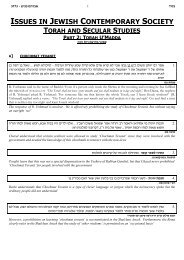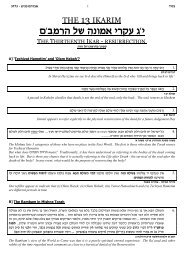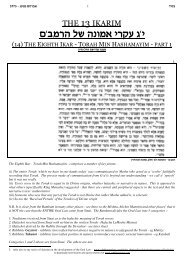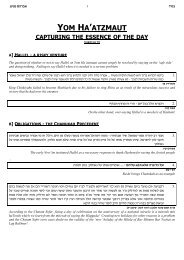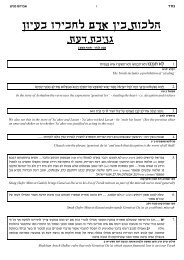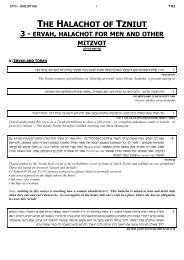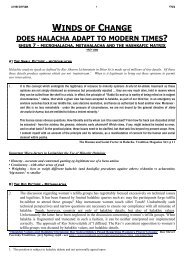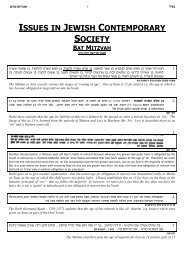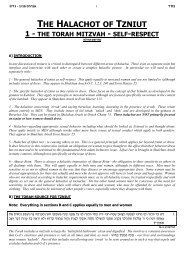Lo Tisna - Lander - Rabbi Anthony Manning
Lo Tisna - Lander - Rabbi Anthony Manning
Lo Tisna - Lander - Rabbi Anthony Manning
Create successful ePaper yourself
Turn your PDF publications into a flip-book with our unique Google optimized e-Paper software.
dbhbn ovrct<br />
1<br />
sxc<br />
BEIN ADAM LECHAVERO<br />
SHIUR 5 - LO TISNA~MACHLOKET<br />
dga, ;ruj - rsbk iufn<br />
hvujt vuhbas t,uba khscs hnb ijfatu lcckc lhjt ,t tba, tk ch,fs vhrcj sj tbahnk ktrah ,hcsk uvk rhxts 1.<br />
ohrmnk ubh,uct usrhu rcsv kdkd,b oukak urcs ukfh tku u,ut utbahu ch,fs ;xuhk<br />
rhxts t,khta v"s zf t,khta cahu ,arp htjt crs ,u,khta<br />
Rav Achai Gaon, in the Sheiltot, spells out how destructive hatred can be, especially between brothers. The hatred of the<br />
brothers for Yosef resulted in galut mitzrayim<br />
THE PROHIBITION OF HATRED<br />
t yj uhkg t¬¬ ,t «k u W º,h ng, t Æjh¸fIT j³fIv W·cck C Whj t, t t¬b G ,t «k 2.<br />
zh:yh trehu<br />
The verse contains two independent mitzvot:- (a) not to hate a fellow Jew; and (b) to give tochacha<br />
'jt lrgc ,adrbv thv vhkg wv vumh rat vtbav ,rgav hf rnuk lhjt ,ch, og tba, tk lunxk cu,fv ofj,b vzk 3.<br />
tba, tk ouan rcug tuv hrvu 'jt ,drsnn sruh tuv vbv ,me uckn uvehjrha kf vz rughau<br />
oa ohhjv rut<br />
The Ohr Hachaim gives a guide as to how to measure ‘lo tisna’ - whenever a person distances themselves somewhat from<br />
a feeling of brotherhood for another<br />
jhfu, jfuv rntu :vuuvc cu,fv rhfzv /// ockc o,tba ,t ,uxfk ohtbuav lrsa rucgc - lcckc lhjt ,t tba, tk 4.<br />
/// /u,ut ,jfuv tku tyjh ratf oat lhkg vhvha tyj uhkg ta, tku 'rxun ,jfu, usnkk ',rjt vumn - l,hng ,t<br />
///// /uka tyjc abug v,t kce, tka<br />
lcckc lhjt ,t tba, kt 'cu,fv rnthu /(vf:tf ,hatrc) lknhct ,t ovrct jhfuvu unf 'jhfu, jfuv hf 'hbhgc iufbvu<br />
hf 'uk shd, tku lckc u,tba ,uxfk tyj uhkg ta, tku 'hsng ,hag vff gusn ubjhfu, kct 'lbumrf tka lk u,uagc<br />
uk rpf,u utyj kg vsu,hu cuah ut 'lk kmb,h u,ut ljhfuvc<br />
oa i"cnr<br />
The Ramban gives two explanations to this verse: (i) that the issur to hate includes open hatred as well as hidden hatred<br />
but the verse spoke of the standard case of hating ‘in one’s heart’. The next mitzvah of tochacha is therefore unrelated to<br />
lo tisna and concerns the standard mitzvah of giving tochacha as mussar; (ii) that the issur to hate is only hatred in the<br />
heart - when a person keeps it bottled up inside them. Rather, a person should give tochacha in the sense of confronting<br />
the other person and dealing with the issue out in the open. Thus, in this explanation, the mitzvot of lo tisna and<br />
tochacha are closely connected<br />
tk 'ucrt ohah ucrecu rcsh uvgr ,t ouka uhpc cvutf uhbpk vtr,, tk vgr lknd ot - lcckc lhjt ,t tba, tk 5.<br />
ouka vhvh lf lu,nu vaga vn kg uvjhfu, jhfuv tkt lckc uvtba, kt 'vaug v,t rat rcsv cuy<br />
oa o"car<br />
The Rashbam says specifically that a person must not pretend to be a friend but secretly hate another person. The Torah<br />
insists that we deal with the issue openly
dbhbn ovrct<br />
2<br />
sxc<br />
tkt h,rnt tk trpx iuaku /lcckc lhjt ,t tba, tk urnt tuvu ub,mek ub,me tuban ubrhvzva thv c"av vumnv 6.<br />
tku oue, tk kg rcug tuv kct utkv vz kg rcug ubht utbua tuva ghsuvu vtbav uk vtrvaf obnt /ckc thva vtba<br />
kfv in ezj r,uh tyj tuv ckv ,tba kct 'lunf lgrk ,cvtu urnt tuvu if od vag kg rcugu ruy,<br />
ca vag, tk ,umn o"cnrk ,uumnv rpx<br />
The Rambam goes so far as to say that the issur of lo tisna is only if a person hates in his heart. But if he hates a person<br />
openly, that is not the issur of lo tisna at all! Such behavior is of course prohibited, but under other mitzvot - such as<br />
ahavat re’im<br />
uc ihta hpk vz utk kg iheuk ihtu 'lcckc lhjt ,t tba, tk rntba vag, tkc rcug uckc ktrahn sjt tbuav kf :v 7.<br />
tk ouan rcug ubht htar ubhta p"gt uprjnvu urhcj ,t vfnv kct 'ckca vtba kg tkt vru, vrhvzv tku 'vagn<br />
/tba,<br />
tba hf cuy sgu grnk vnutn iubnt ,t oukact rcs tku ohgarc rntba unf eu,ahu ubnyah tk ahtk aht tyjhaf :u<br />
jfuv rntba 'hbukp rcsc hk ,tyj vnku lfu lf hk ,hag vnk uk rnuku ughsuvk uhkg vumn tkt 'iubnt ,t oukact<br />
ohvktv kt ovrct kkp,hu rntba hrzft kjunv tvh tku 'kujnk lhrm uk kujnk ubnn aecu rzj otu 'l,hng ,t jhfu,<br />
u 'v vfkv u erp ,ugs ,ufkv o"cnr<br />
The Rambam rules that, even if a person hits and insults someone else, such behavior does not fall under the issur of <strong>Lo</strong><br />
<strong>Tisna</strong>. In the next halacha, the Rambam deals with the obligation for someone who feels hurt to give tochacha - i.e. to<br />
confront the other person with his grievance and deal with it<br />
,t ahtcn uhbpc tkau uvgr ,t rcsh ouka uhbpc ot iudflcckc lhjt ,t tba, tks utkc if od rpxnv rcug ohngpku 8.<br />
ohrjt hbpc ujhr<br />
z ihutk ohhj .pj xk vjh,p<br />
The issur of hating someone ‘secretly’ is not only if a person keeps it inside himself. If they speak lashon hara and smear<br />
another person in private, whilst pretending to be friendly in public, this is the issur of lo tisna. The essence of lo tisna is<br />
that the victim has no opportunity to deal with the accusation or defend himself. In a public feud the victim can at least<br />
take steps to deal with the issue and protect himself<br />
vz utkc rcug ubht uprjnvu urhcj ,t vfnvu lcckc lhjt ,t tba, tk rntba ,"kc rcug uckc ktrahn sjt tbuav 9.<br />
s e"x ube inhx vrurc vban<br />
Whilst there are other interpretation in the Rishonim of the issur of <strong>Lo</strong> <strong>Tisna</strong>, the Mishna Berura rules the approach set<br />
out above as the final halacha<br />
A MITZVAH TO HATE<br />
vhsujk sudhz t,tu tyj vhcuys tv hf /hshjh uc shgnu urhcjc vurg rcs vturvu /// itbua tuv lurc ausev vaka 10.<br />
sg oueh tk (yh ohrcs) ch,fs 'iht :vhk rnt sdbhn sudhzu tyj vhcuy :vhk rnt /sudhzk vhsdb /tpp crs vhne vhc shvxtu<br />
/u,tbak r,un :cr rnt ejmh cr rc ktuna hcr rnt /vhc ,epn te tnkgc gr oa - vhc ,svxt lsujk ,tu ahtc sjt<br />
:rnt ejmh rc injb cr /vurg rcs uvht vhc thzjs /// tbua htn /utan ,j, .cr ltba runj vtr, hf (df ,una) rntba<br />
gr ,tba wv ,trh (j hkan) rntba 'u,tbak vumn<br />
:dhe ohjxp<br />
If one person sees another doing a serious aveira, he may not come forward alone as a single witness. In fact, this would<br />
be prohibited as lashon hara since two witnesses are needed to punish the wrongdoer. However, it is permitted to hate<br />
the wrongdoer and the Gemara concludes that it is in fact a mitzvah to hate him<br />
;h x«h i P ;h x«h t«k UBFh oh gC r<br />
t /// :g J r<br />
v , t Ugh J r<br />
v u ehSM v , t UehS<br />
m v u oUyp JU yP J N v k t UJDb u oh Jbt ihC chr vh vh h F 11.<br />
(lhjt utre vekanu gar utrue ouhv kf - h"ar) :Whbhgk Wh j t vk eb u vC r vF n vK t kg I,«F vk<br />
d't:vf erp ohrcs<br />
The Torah calls someone who has done an aveira a ‘rasha’ but, once they have received their punishment, they are again<br />
called ‘achicha’. Thus, when they are not considered ‘achicha’ they are not included in the category of people whom it is<br />
forbidden to hate - lcckc lhjt ,t tba, tk
dbhbn ovrct<br />
3<br />
sxc<br />
,t tba, tk rnut cu,fvu ktrahn tbua ktrahk vhvh lthvu 'okugv ,unutn tk 'ktrahn tuv vru,c rntba tbuav 12.<br />
vcua, vagha sg utbak vumn vz hrv rzj tku uc vr,vu vrhcg rcga usck uvtra iudf ohnfj urnt 'lcckc lhjt<br />
ugarn ruzjhu<br />
sh vfkv dh erp apbv ,rhnau jmur ,ufkv o"cnr<br />
The Rambam rules that it is a mitzvah to hate a rasha, meaning someone who has done an issur Torah and has not yet<br />
done teshuva<br />
uhkg kunjku ucvtk vcuju 'ktrah kkfc xbfb tuv hrv ',h,nt ovc u,buntu ukkv ,usuxhv kf ostk ohnhhe uhvh ratfu 13.<br />
,urcd,vu u,ut, ,njn ,urhcgv in ,uhvk kufha vn vag ukhptu 'vujtvu vcvtv in vz kg vz ub,ut wv vuma vn kfu<br />
grv urmh<br />
h erp ihrsvbx ,fxn o"cnrk vbanv aurhp<br />
Yet the Rambam, in his perush on the Mishna, clearly says that as long as a person believes in the 13 principles of<br />
emuna, it is a mitzvah to love them even if they do aveirot! How can there be a mitzvah to love a person whom one is<br />
also required to hate!<br />
IN g c«zg T c«zg Ik c«zg n Tk s j u It ¬ n , j T .c«r Wtb«G rInj v t r<br />
, h F 14.<br />
v:df ,una<br />
If a person sees the animal of his enemy collapsing under a load he must help to unload the animal<br />
urmh ,t ;ufk hsf tbuac vumn - iugyk tbuau eurpk cvut :gna t, 15.<br />
:ck tghmn tcc<br />
Unloading an animal is a bigger mitzvah than helping to load it up since there is also a mitzvah of ‘tzar ba’alei chayim’.<br />
Nevertheless, Chazal tell us that if there is a choice between loading the donkey of an enemy or unloading the donkey of a<br />
friend, one should help the enemy in order to overcome the yetzer hara to hate them<br />
,t ;ufk hsf tbuac vumn iugyk tbuau eurpk cvut ibhrnt (:ck ;s n"c) ,uthmn uktcs rnt, otu - vurg rcs uc vtra 16.<br />
ohnf (zf hkan) ch,fs u,ut tbua urhcj od utbua tuva iuhf k"hu !u,tbak vumns iuhf lhha rmh ,hhpf vn t,avu /urmh<br />
rmh ,hhpf lhhau vrund vtba hshk lf lu,n ihtcu ostk ostv ck if ohbpk ohbpv<br />
:dhe ohjxp ,upxu,<br />
Tosafot explain that the passuk in 14 above is indeed talking about a rasha and you are indeed allowed to hate them.<br />
However, since you hate them (albeit with the Torah’s permission), they will hate you back personally without<br />
permission. As a result of that, you may be tempted to hate them back in turn with what Tosafot call a ‘total hatred’ i.e. a<br />
personal hatred. This is the yetzer hara that you must fight<br />
grv smn vtba !,nt iv ivh,au f"d ocvtk vumn o,utbak vumna ovh,ubugn uca tku ojhfuvu uhkt ohcruenv odu 17.<br />
,hektv oapb vhjnv ofu,ca ,uekt .umhb tuva ovca zubdv cuyv whjc smn vcvtu ovca<br />
ck erp - iuatr ekj - thb,v rpx<br />
The Ba’al Hatanya says the same idea - hate the negative root of sin within the person yet love the sinner for the spark of<br />
Godliness which resides in every human being<br />
rcug hpkf od vrh,v tk vru,v hf .vba ohrag hbpk k'mz eue v'htrv irn uauseu ktrah iutd hk vkhd ovhrcs aurhp 18.<br />
vru,va tkt /uhpkf od lunf lgrk ,cvtu ,umnn ub,ut vryp tku lcckc lhjt ,t tba, tk ka ruxhtv ,t vrhcg<br />
ka vagv ,uumn ukmt ur,uv tku vzn r,uh tk kct .u,ut tubak vumn vrhcgv ,rdxncu 'vrhcgv kg u,ut tubak v,um<br />
u,ut od uvunf cuvtk chhj tuv haht iputc hf .tba, tk ka ,'kvu ',cvtu'<br />
1954 - t:t - jrznv rut - irud vnka cr<br />
Rav Goren rules that this is also how Rav Kook explained the dynamic of the mitzvah
dbhbn ovrct<br />
4<br />
sxc<br />
obj ,tba uc v,hva hbpn crj vn hbpn ohsxj ,ukhndu ,umncu vru,c ihexug uhva hba asen 19.<br />
:y tnuh<br />
The Second Temple was destroyed due to Sinat Chinam. This does not mean hatred for no reason. It means hatred with<br />
no basis in Torah - i.e. personal hatred as opposed to passionate hatred of a rasha’s lifestyle, whilst at the same time<br />
loving and respecting him as a person<br />
20.<br />
,hatrc xk vnsev - anuj kg chmbv aurhp<br />
The Netziv (19C Russia) explains that the sinat chinam which destroyed the Second Temple was caused by tzaddikim who<br />
were acting lesheim shamayim! The problem was that they personalised their disagreements to the stage that they called<br />
other people apikorsim - heretics, just because they opposed their position. G-d cannot bear tzaddikim like this!<br />
It follows from the above that a person is allowed to feel passionate dislike for the lifestyle of a rasha but not to hate<br />
them personally. However, when dealing with someone to whom the issur of <strong>Lo</strong> <strong>Tisna</strong> does apply - i.e. achicha - there<br />
is no justification for feeling a passionate dislike even for their lifestyle or actions, since they are not a rasha.<br />
ivc ruzjk umr tku ohngp vcrv otyj kg o,ut jhfuba rjt o,utbak vumn tkt 'ruxht uc iht ohgarv ,tbac kct 21.<br />
jkr vumn lubhjv rpx<br />
It is clear from the Sefer Hachinuch that one is only allowed to hate a rasha after having given them tochacha a number<br />
of times<br />
22.<br />
jf:c suh aht iuzj<br />
The Chazon Ish rules that no-one is an intentional sinner until they have received a proper tochacha and since we cannot<br />
give tochacha these days, almost no-one can be said to be acting ‘bemazid’. According to many authorities today, we are<br />
no longer able to give tochacha properly. As such, we cannot treat any person as a rasha - maybe they would have done<br />
teshuva if only we could have given them proper tochacha! It therefore emerges (i) that very few people today are<br />
reshaim and (ii) even those few who may be reshaim must never be hated personally<br />
THE SPECIAL PROHIBITION OF MACHLOKET<br />
r¸Jt i g n Âk  k Àt r<br />
Gh h´b ck iIºrFz v : jCz Nk hU¬P m oU g E rhu oh·p r<br />
¬ v Uch r e v r¬Jt , J ºjB v ,I´T j n , t µ i Àv«F v r´zgk t j ºEHu 23.<br />
:Ik vJ«nsh C v rC S rJtF I º, sgfu jr«e f vh vht«ku v h´b pk , r« y e rh¬y e vk tU ºv Æi«rvt gr³Z n t´«k r JÂ Ât rÀz Jh´t c r¹<br />
eht «k<br />
v-s:zh rcsnc<br />
There is a specific mitzvah to remember the episode of Korach so that we should not be like him and his supporters<br />
/// ,eukjn kgc vhvh tkau ,eukjnc ehzjh tka vz kkfcu Iº, sg´f u Æj r« ȩ f v³h v ht«k u ch,fs vbuvfv kg rgrgk tka 24.<br />
cke enx<br />
The Smak explains that the issur applies to all machloket
dbhbn ovrct<br />
5<br />
sxc<br />
jref vhvh tku :rntba 'utkc rcug ,eukjnc ehzjnv kf vfrck oburfz ubh,ucr urnt - u,sgfu jref vhvh tku jb 25.<br />
u,sgfu<br />
tku jb v"s d rga vbuh ubhcrk vcua, hrga rpx<br />
Rabbeinu Yona considers the issur to make or perpetuate machloket to be one of the 613 mitzvot<br />
rcug ,eukjnc ehzjnv kf :cr rnts ',eukjnc ihehzjn ihta itfn :ahek ahr rnt orhctu i,s kt lkhu van oehu 26.<br />
wv rnthu (s ,una) o,v ch,fu 'uk van shc tfv ch,f 'grymhk hutr :rnt hat cr /u,sgfu jref vhvh tku rntba utkc<br />
lehjc lsh tb tcv sug uk<br />
/he ihrsvbx<br />
Chazal see from Moshe’s approach to Datan and Aviram that a person must try to avoid machloket and, even if they are<br />
clearly in the right, must ‘go the extra mile’ to make shalom!<br />
oak tuva ,eukjn thv uzht /ohhe,vk vpux iht ohna oak vbhtau 'ohhe,vk vpux ohna oak thva ,eukjn kf 27.<br />
:u,sg kfu jre ,eukjn uz ohna oak vbhtau /htnau kkv ,eukjn uz ohna<br />
zh vban v erp ,uct ,fxn vban<br />
There is a concept of ‘machloket leshaim shamayim’ - such as that if Hillel and Shamai<br />
lu,n urnta unf 'ohhe,n vzu ',ntv dhavk ,eukjn v,utn aeucnv ;uxvu ,hkf,v 'ohna oak thva ,eukjnvu 28.<br />
vmrbv ,hkf, 'ohna oak vbhta ,eukjnu /kkv ,hcf vfkva htnau kkv ,eukjnc rrc,ba unfu ',ntv rrc,h jufhuv<br />
o,buuf ;uxu ,hkf,a u,sgu jrue ,eukjnc ubhmna unf 'ohhe,n ubht ;uxv vzu 'jumhbv ,cvtu vrrav ,aec thv vc<br />
lphvk uhvu vrravu sucfv ,aec v,hv<br />
zh vban v erp ,uct ,fxn trubyrcn vhscug wr<br />
Machloket leshaim shamayim is defined as the search for truth. If so, there are no losers - only winners when the truth is<br />
finally reached. Machloket shelo leshaim shamayim is intended to achieve victory over a loser. It is essentially<br />
egocentric<br />
ykc ,utv vagha rapta hpus uckc ah ,u,utv hp kg ihntnva 'vaga ,u,utv hbpn ktrah uc ubhntv tk ubhcr van 29.<br />
sngnc uc ubhntv vncu ////// vtucbv kg vhtr thcvk tk 'otag lrumv hpk rcsnc van vaga ,u,utv kf tkt ';uafu<br />
ubtu uhkt rcsn kuevu kprgv kt adb tuvu ohshpkvu ,ukuevu atv rjt tku ugna ubhbztu rz tku utr ubhbhga hbhx rv<br />
hpus uc ihta ,nt thva u,tucbk vhtrv thv usck hbhx rv sngna ihbnu ///// lfu lf ivk runt lk van van ohgnua<br />
tk vz rcs osuea kkfn 'okugk ubhnth lc odu lng hrcsc ogv gnah rucgc ibgv cgc lhkt tc hfbt vbv rntba<br />
vcajnu ruvrv vhrjt aha ,ubntb tkt okugk ,snug thva ,ubntb uc ubhntv<br />
t vfkv j erp vru,v hsuxh ,ufkv o"cnr<br />
The Jewish people did not doubt that Moshe was authentic. There emuna in him was total and stemmed from the Har<br />
Sinai experience. In fact the machloket of Korach was personal in nature - sinat chinam. Even if the content of the<br />
argument is legitimate, once the issues become personal, this is called sinat chinam<br />
vbvu///// /ussud,, tk vkg,h urnt tuvu vrz vsucg hscug uagha unf ubracc yra ,uagn ubrhvzva thv v"nv vumnvu 30.<br />
tk ussud,, tk urntu ohmucev ;ukhju ovhdvbnc rhgv hbhs h,c eukhjn vrvztv if od vz utk kkfca (:dh ,unch) urnt<br />
sm kg if od tuv u,sgfu jref vhvh tku rntba utkc rcug ,eukjnc ehzjnv (/he wvbx) ornt ifu /,usudt ,usudt uag,<br />
arsv<br />
vn vag, tk ,umn o"cnrk ,uumnv rpx<br />
The Torah contains an prohibition of factionalism - splitting into rival groups. This issur of lo titgodedu is also designed<br />
to minimize machloket



